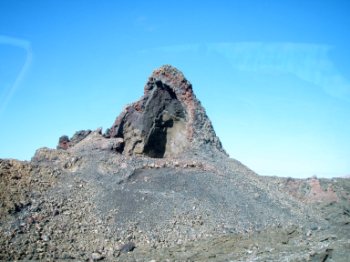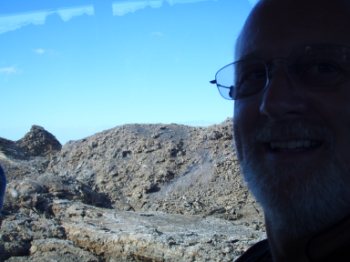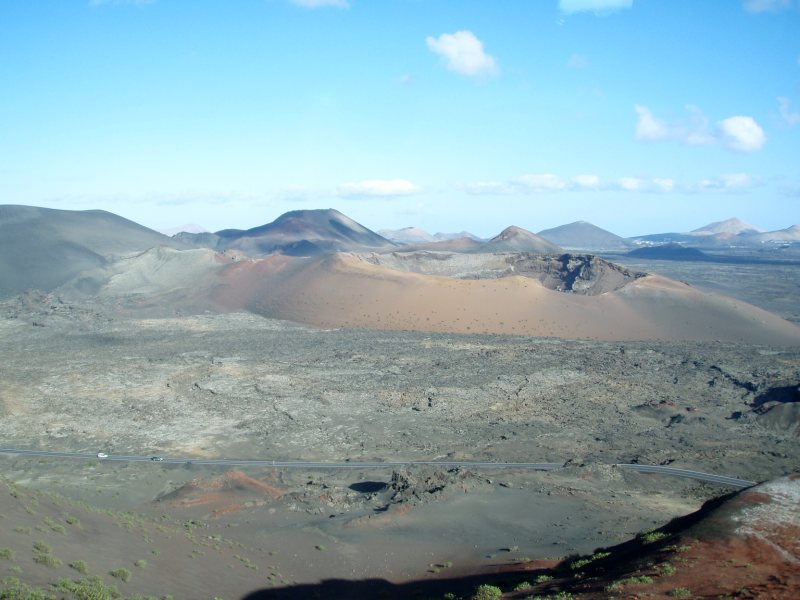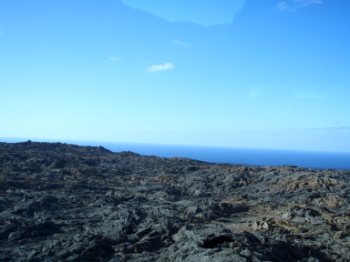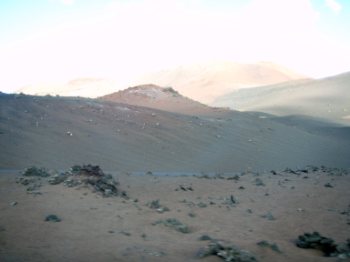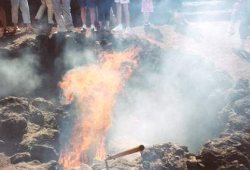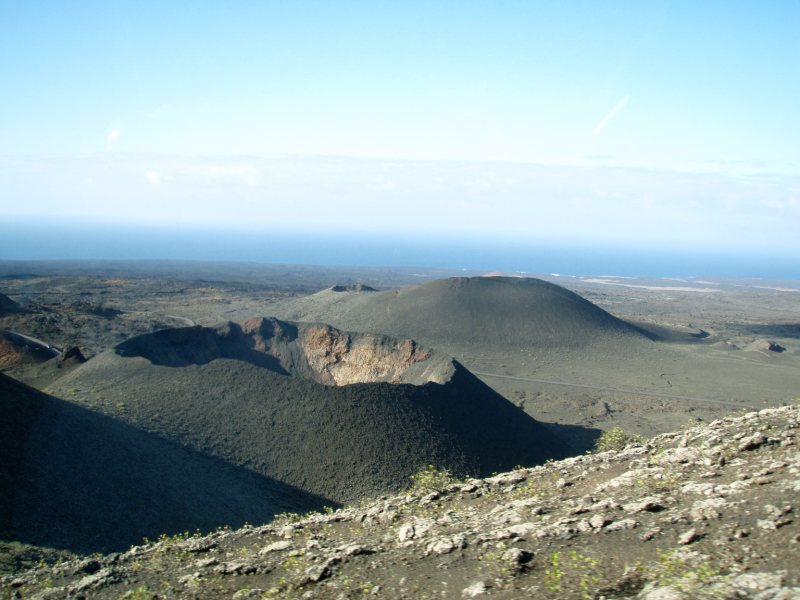Fire Mountain

|
Montanas del Fuego
After our camel ride we continued along the road, pulled off a short while later, stopped at a hut to pay 8 Euros each, to drive up the hill for the most famous view on all of Lanzarote, Fire Mountain. As soon as we had parked the car, a guide hustled us to a waiting coach, which took us some 14 kms through dug out, winding roads, cut into the lava itself giving unique views of numerous lined up volcanos. The so named "tongues" of lava, the "hornitos" and the volcanic tubes in the area. The coach had a commentary tape in English and German and stopped regularly for photo opportunities through the glass. We were not allowed to wander, but, once a lava flow always a lava flow. Nonetheless very interesting to get an idea of the sheer size of the vista. Must slip back to the "Hornitos", I asked Bear to dictate whilst I typed the factual bits for this blog. I heard "Horny Toes", I always get him to look at the finished blog for comments, photo approval and general checking. When I had inserted the pictures, as usual I called him over. Before correction he saw "Horny toes" and laughed to the point of wet eyes. If he had said "One-e-toes" I may have stood a better chance. Paint Pepes face PURPLE. She had already tipped over her sewing kit, had a exploding troll line all knotted and her tooth socket is still throbbing and was not in the mood to mess with. WATCH PEPE TAKE SEVERAL SLUGS OF NEAT VODKA Do you know how to pull someone through an engine casing - Pepe does. Crank Bear Crank. Crank Bear Crank. While HE wipes the grease off I will mention that a crab in Spanish is CRANGREJO or CRAN-GRE-(PHLEGM with an O sound). Rabbit is CANEJO ditto pronunciation, neither of which Bear can do. Spanish zero %
The tube, Bear on the bus, more
lava.
Some 20 million years ago, the earth first coughed up
nearby Fuerteventura as a molten rock in the Atlantic, off the coast of Morocco.
Lanzarote followed, around 4 million years later. The rest of the Canary Islands
erupted out of the sea another 2-3 million years on, each with its own volcanic
core. Lanzarote is different in that its volcanoes are merely dozing and any
forthcoming indigestion could well belch up a little more enlargement for the
island - as it did during the period 1730-1736 and again in 1812-1824. So if
you're interested in seeing the effects of Nature in the raw, then
Lanzarote is the place to
go.
From 1730 to 1736, a scenery of fertile land situated in the south west of
Lanzarote, was struck by one of the most important eruptions in the history of
Volcanology. During these years, the cultivated fields were transformed into one
of the most extensive lava fields: more than twenty villages and hamlets were
buried by the rage of the craters.
The very few plants we saw. High above the park road with Yaiza in the background. According to the diary of the parish priest of Yaiza, Don Andrés Lorenzo Curbelo: "On the first day of September 1730, between nine and ten at night, the earth suddenly opened close to Timanfaya, two leagues from Yaiza. During the first night an enormous mountain rose up from the bowels of the earth, with flames shooting from its summit, which continued burning for 19 days." A later entry tells us: "On 18th October three new openings formed above Santa Catalina from which dense smoke emerged, which scattered over the entire island. The explosions which accompanied this phenomena, the darkness caused by its mass of grains and the smoke which covered the island, forced the inhabitants of Yaiza to flee their homes."
The lava is high above the sea with sheer edges. The second photo again through the coach window shows the flow. The apparently barren vista. In the year 1824 the last volcanic eruption in Lanzarote. The brutal action of nature shaped this striking area of 51 square kilometers which was declared a National Park in 1974. Despite its hostile appearance to any kind of life , there are several species of animals such as the Haria Lizard, the ravens, the seagulls, the Cory's shearwater and a great variety of lichens (more than 300 different species which gets the Lichenologists in a pure frenzy). Once off the coach time to mill about the grockle shop and look at the permanent exhibition with interpretative displays, a simulated eruption and a multi-media audio visual programme which takes place in a building of majestic architecture by Manriques. The use of black and white, glass and ornamentation makes you feel like you have stepped into the next room at Mirador del Rio or the Cactus Garden.
The guide stoked up the fire and within seconds it was burning like a bonfire on November 5th, he then threw straw into the pit. The temperature ten cms below the surface here is around 140 degrees centigrade and at six meters below ground it reaches 400 degrees. This is shown here by the fire pit.
The artificial geysers produced by pipes sunk into the ground. When water is poured into the bowels of the earth, it shoots it out again in spectacular fashion.
The most famous view of fire mountain, thankfully our little camera has a 'through glass' button.
All in all is it little wonder that the Timanfaya National Park contains what have been named the Mountains of Fire. |
